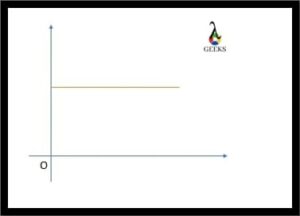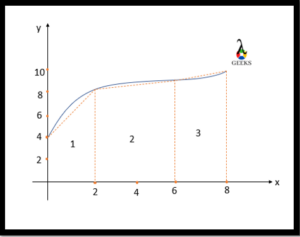Discover the method to calculate distance using a velocity-time graph, an essential tool for visualizing the relationship between an object’s velocity and time. This guide breaks down the process and makes it easy to understand how to interpret these graphs for practical physics applications.
By plotting the velocity-time graph of a complete journey of a moving body, we can also find the distance covered. The distance is determined by calculating the area under the graph, both positive and negative sides.
The velocity and time graph shows the speed of the object at a particular time. While plotting this graph, we take the value of velocity on the vertical axis that is the y-axis. Similarly, the time is taken on the x-axis, the vertical one. Just like the position-time graph, we can find the slope of the velocity-time graph. The slope is calculated by the formula:

Here,

Since we take time on the x-axis then:

Similarly,

We take velocity on the y-axis so;

Therefore the formula for velocity-time graph becomes;
Slope=(v2-v1)/(t2-t1)
The unit for velocity is meter per second (m/s), and that of time is second (s).
Therefore if we put the unit in the above slope formula, we get.
slope=ms-2
We know that the unit is that of the acceleration. So the slope of the velocity and time graph gives the value of the acceleration of the object.Â
If the steepness of the slope is in a downward direction, then its value would be negative. Hence the acceleration would also be negative. The negative acceleration means that the velocity is decreasing. Hence the downward slope would mean that the body is decelerating. The gentle rise of the slope of a graph means that its value is positive, so the body accelerates.

When the slope of the graph is zero, that is, it is parallel to the time axis. In this circumstance, the acceleration becomes zero. And hence it means that the velocity remains constant throughout the journey.

Now let us know how to find the distance in velocity time graph. The area of the graph gives the value of the entire distance that an object covers. To understand it step by step, check below.
The above graph shows the velocity and time relation of a moving car. We can clearly see that originally the body was accelerating, then the velocity became constant, and after that, it started decelerating. To find the distance divide the graph into triangles and trapezium, as shown above. Now the last thing is to find the values of figures and add them.
The area of triangle 1 =
(1/2)*base*height
(1/2)*2*8
The area of triangle 1 = 8
The area of trapezium 2 =
(1/2)*(a+b)*height
(1/2)*(8+12)*3
The area of trapezium = 30
The area of triangle 3
=(1/2)*base*height
=(1/2)*3*12
The area of triangle 3 = 18
To find the area of the graph, add all three areas:
Distance covered = Area 1 + Area 2 + Area 3
Distance covered = 8 + 30 + 18
Distance covered = 56
This is the total area that the car covered. So the distance in the velocity time graph is calculated by finding the area of the graph.
How to find distance from a curved velocity time graph
For a curved velocity time graph, the distance is traveled by finding the area under the graph. Take the above graph; the slope here is not straight. It is curved; that is, it keeps increasing or decreasing.

The very first step is to divide the graph roughly into triangles and trapeziums. A minute up and down can be ignored. In this way, we get to know the correct value of the distance traveled by the body. After dividing the graph into triangles and trapeziums, the next is to find the area of each figure. Therefore the area of the triangles and trapeziums are calculated as:
Area 1 = (1/2)*(4+8)*2
Area = 12
Area 2 =(1/2)*(8+9)*4
Area 2 = 34
Area 3 =(1/2)*(9+10)*2
Area 3 = 19
The last step is to add the areas of the rough figure and get the value of distance traveled.
Distance covered = Area 1+ Area 2+ Area 3
Distance covered = 12 + 34 + 19
Distance covered = 65
Therefore the distance for the above graph is 65
Frequently Asked Question (FAQs)
What is the velocity time graph?
The graph showing a relation between velocity and time of a moving body is known as the velocity time graph.
In the velocity time graph, we plot the velocities of the object on the y-axis and the time taken on the x-axis. It tells the speed of the moving particle at a particular time. The rising slope says that the velocity is increasing, and downward steepness says that velocity is decreasing.
What does the slope of the velocity time graph depict?
The steepness of a line of the graph is its slope. It provides the value of some physical quantity.
In the velocity time graph, by finding the slope, we get the value of the acceleration of the body. If the slope is positive, that means the body is accelerating. If the slope is downwards, it infers that velocity keeps decreasing with time.
How to show that the velocity is constant by a velocity time graph?
With a velocity time graph, we can show all kinds of velocity, increasing, decreasing, changing, or even constant ones too.
When the slope is zero, that means that it is parallel to the horizontal x-axis; that is, the time means that the velocity is constant. This shows that at different times the value of the velocity remains the same; hence it is constant.
How to find distance in velocity time graph?
With the help of a velocity time graph, we can easily find the total distance covered by an object during the whole journey.
The area of the velocity time graph is used to find the exact distance traveled by the object. To find the area, we divide the graph into triangles and trapeziums and then find their area and add them. And hence the magnitude of distance is known.
Can we find displacement from the velocity time graph?
No, the velocity time graph does not provide information about the displacement.
By finding the area under the velocity and time graph, we get the distance traveled and not the displacement. We can not find the displacement from the velocity-time graph. It is because, for displacement, we need to know the initial and final positions that are not provided by this graph.
Also Read:
- How to find velocity with height
- How to measure velocity of fluid in porous medium
- Orbital velocity
- Is velocity zero at the highest point
- Is horizontal velocity constant
- How to find velocity
- Horizontal speed vs horizontal velocity
- How to calculate velocity in wormholes
- How to find velocity of a wave
- How to derive velocity in wave particle duality
Hi,
I am Rabiya Khalid, I have completed my masters in Mathematics. Article writing is my passion and I have been professionally writing for more than a year now. Being a science student, I have a knack for reading and writing about science and everything related to it.
In my free time, I let out my creative side on a canvas.